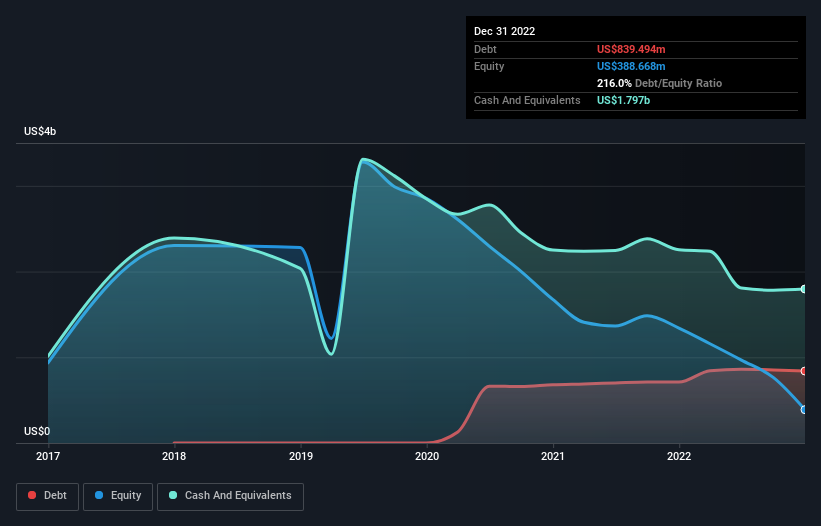
David Iben put it well when he said, 'Volatility is not a risk we care about. What we care about is avoiding the permanent loss of capital.' So it might be obvious that you need to consider debt, when you think about how risky any given stock is, because too much debt can sink a company. As with many other companies Lyft, Inc. (NASDAQ:LYFT) makes use of debt. But should shareholders be worried about its use of debt?
When Is Debt Dangerous?
Debt and other liabilities become risky for a business when it cannot easily fulfill those obligations, either with free cash flow or by raising capital at an attractive price. Ultimately, if the company can't fulfill its legal obligations to repay debt, shareholders could walk away with nothing. While that is not too common, we often do see indebted companies permanently diluting shareholders because lenders force them to raise capital at a distressed price. Having said that, the most common situation is where a company manages its debt reasonably well - and to its own advantage. The first thing to do when considering how much debt a business uses is to look at its cash and debt together.
See our latest analysis for Lyft
How Much Debt Does Lyft Carry?
The image below, which you can click on for greater detail, shows that at December 2022 Lyft had debt of US$839.5m, up from US$711.4m in one year. However, its balance sheet shows it holds US$1.80b in cash, so it actually has US$957.3m net cash.

A Look At Lyft's Liabilities
We can see from the most recent balance sheet that Lyft had liabilities of US$3.13b falling due within a year, and liabilities of US$1.04b due beyond that. On the other hand, it had cash of US$1.80b and US$267.3m worth of receivables due within a year. So it has liabilities totalling US$2.10b more than its cash and near-term receivables, combined.
This deficit isn't so bad because Lyft is worth US$3.63b, and thus could probably raise enough capital to shore up its balance sheet, if the need arose. But it's clear that we should definitely closely examine whether it can manage its debt without dilution. Despite its noteworthy liabilities, Lyft boasts net cash, so it's fair to say it does not have a heavy debt load! The balance sheet is clearly the area to focus on when you are analysing debt. But ultimately the future profitability of the business will decide if Lyft can strengthen its balance sheet over time. So if you're focused on the future you can check out this free report showing analyst profit forecasts.
Over 12 months, Lyft reported revenue of US$4.1b, which is a gain of 28%, although it did not report any earnings before interest and tax. With any luck the company will be able to grow its way to profitability.
So How Risky Is Lyft?
We have no doubt that loss making companies are, in general, riskier than profitable ones. And in the last year Lyft had an earnings before interest and tax (EBIT) loss, truth be told. Indeed, in that time it burnt through US$352m of cash and made a loss of US$1.6b. While this does make the company a bit risky, it's important to remember it has net cash of US$957.3m. That means it could keep spending at its current rate for more than two years. With very solid revenue growth in the last year, Lyft may be on a path to profitability. Pre-profit companies are often risky, but they can also offer great rewards. When analysing debt levels, the balance sheet is the obvious place to start. But ultimately, every company can contain risks that exist outside of the balance sheet. To that end, you should be aware of the 3 warning signs we've spotted with Lyft .
At the end of the day, it's often better to focus on companies that are free from net debt. You can access our special list of such companies (all with a track record of profit growth). It's free.
New: AI Stock Screener & Alerts
Our new AI Stock Screener scans the market every day to uncover opportunities.
• Dividend Powerhouses (3%+ Yield)
• Undervalued Small Caps with Insider Buying
• High growth Tech and AI Companies
Or build your own from over 50 metrics.
Have feedback on this article? Concerned about the content? Get in touch with us directly. Alternatively, email editorial-team (at) simplywallst.com.
This article by Simply Wall St is general in nature. We provide commentary based on historical data and analyst forecasts only using an unbiased methodology and our articles are not intended to be financial advice. It does not constitute a recommendation to buy or sell any stock, and does not take account of your objectives, or your financial situation. We aim to bring you long-term focused analysis driven by fundamental data. Note that our analysis may not factor in the latest price-sensitive company announcements or qualitative material. Simply Wall St has no position in any stocks mentioned.
About NasdaqGS:LYFT
Lyft
Operates a peer-to-peer marketplace for on-demand ridesharing in the United States and Canada.
Undervalued with reasonable growth potential.


